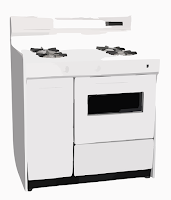So, the answer to the question...
Can I use acrylic paint on glass?
Painting Glass With Acrylic Paint
Gather Your Supplies
Here is a list of the supplies you may need for painting glass with acrylic paint. These supplies may vary depending on your project.
- Your Glass - depending on what your project is.
- Palette - Or something to squeeze your paint onto. See my page on How To Make A Wet Palette.
- A pattern or design of what you want to paint unless you prefer freehand. Check the Free Patterns page.
- Acrylic Glass Paint or Acrylic Enamel Paint - water-based. What you need for paint will depend on what you decide to use for your project. Plan ahead with colors and mediums you'll need.
- Glass and Tile Medium - If you are going to use regular acrylic paint.
- Clear Medium - Used for thinning glass paint. Water is not recommended for thinning glass paint if you want it to be more transparent or you need to thin it.
- Glass Outliner - Good for Faux Stained Glass Projects.
- Glass Paint Marker Pens - Good for writing and details or touch-ups.
- Paint Brushes - Again depending on what you'll be painting will determine what you'll need. Soft bristle brushes work well. You'll probably need a round and a flat one, use your paint brushes that you use for your other acrylic paint projects. You can also use things like daubersor pouncers for polka dots or the end of your paint brush for tiny dots. Sponge applicators work well too. See my page on Best Brushes For Acrylic Paint.
- Stencil Tape - May be use to make stripes. Make sure to remove the tape while the paint is still wet or the paint may lift off with the tape.
- Craft Blade - This is handy when painting on flat glass after it's dry to correct mistakes when you're making lines for faux stained glass.
- A Sharpie Pen - This is also a handy tool to use for touch up on things that will not be used for eating or drinking.
- Spray-on Sealant - For decorative glass only, can be used instead of heat setting, not on glass that will be used for food purposes.
- A container of water to wash the brushes with.Paper towels or rags.
- Newspapers or plastic to protect your work table.
- Apron or paint shirt.
Prepare Your Surface
.
Tips On Painting Glass
Here's some more tips on painting glass:
- It is not recommended to mix glass paint with water. This weakens it's strength and lessens its ability to adhere to the glass. If you want to thin the paint use a clear medium for washes and to create a translucent effect.
- If you are painting and you see air bubbles be sure to pop them with a toothpick or a needle.
- If you make a mistake while the paint is wet you can wipe it off with a cloth.
- Remember if you are painting on glass, the color that you put down first will be the color that will show on the other side of the glass. If you plan to blend colors, add shading, or other things on top of the bottom layer that has already been applied to the glass, you won't be able to see it on the other side of the glass if the bottom layer has already dried. So, plan ahead before you apply your first layer or coat.
- If you're making faux stained glass, paint the outline of your design first and let it dry before filling it in.
- An easy way to make a glass painting or faux stained glass is to use the glass from a picture frame then you can either put paper or foil behind it and put it back into the frame as normal or discard the backing and use super glue to glue the glass to the frame to let the light in behind it.
Curing and Setting Your Project
- Let your project dry for 24 hours to cure it and then there are options to setting it.
- The first option is to place the glass in the cold oven. Then turn the oven on to 350 degrees. It must heat gradually to avoid breakage. Once the oven reaches 350 degrees, start timing it. One half hour for most glass paints and slightly longer (45 minutes) if you used regular acrylic paint with glass and tile medium. It's best to read the instructions on the paint bottle. Wait for the oven and glass to completely cool before removing it from the oven. Use the exhaust fan for the fumes and let the oven air out after you're done. Do not use your glassware for 72 hours after that. Then wash it by hand without scrubbing it before using it.
- If you choose not to bake it you can air dry it for 21 days.
- If your project is too big for the oven, set it with a hairdryer on low heat not placing it too close to the project.
- You can also place your items in the sun to set them.
- Spray-on sealant can be used instead of heat setting on decorative glass only, not glass that will be used for food purposes.
Take Care Of Your Project
Some paint is top rack dishwasher safe, others can only be hand washed, and some cleaned with a damp cloth. It's best to read the instructions on the paint bottle but I recommend only hand washing your food and drink ware and wiping decorative items with a damp cloth.
Check back soon. I have lots of Acrylic Painting Ideas to share with you.
Please feel free to leave your thoughts and ask me any questions you have in the comments section.
This page contains ad links.








Your welcome!
ReplyDeleteMy granddaughter used acrylic paint to paint on a window for me & I want to hang this outside on my patio. How do I seal this & protect it from the “elements”?
ReplyDeleteVery impressive. You made my queries clear. Wonderful explanation.
ReplyDeleteThank you Shala. I'm happy you like the site.
ReplyDeleteA big thanks to make our queries clear. An interesting blog to visit.
ReplyDeleteYou're welcome. Happy you like it!
ReplyDeleteVery Informative post. Thanks for sharing this article.
ReplyDeleteI read your post. It's really very informative. Thanks for sharing information.
ReplyDeleteI want to paint a hummingbird feeder red again. It is still red but faded. I have acrylic paint and spray sealer. Can I paint over the red glass?
ReplyDelete